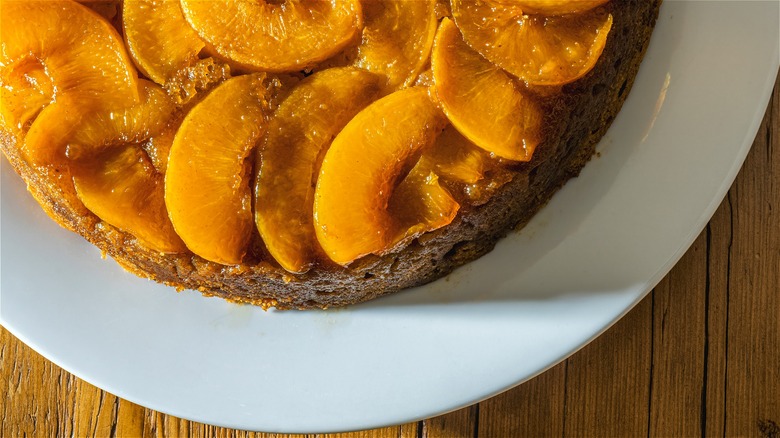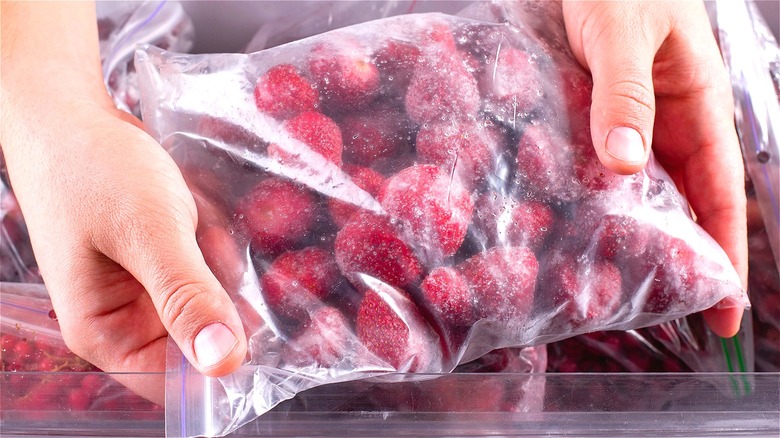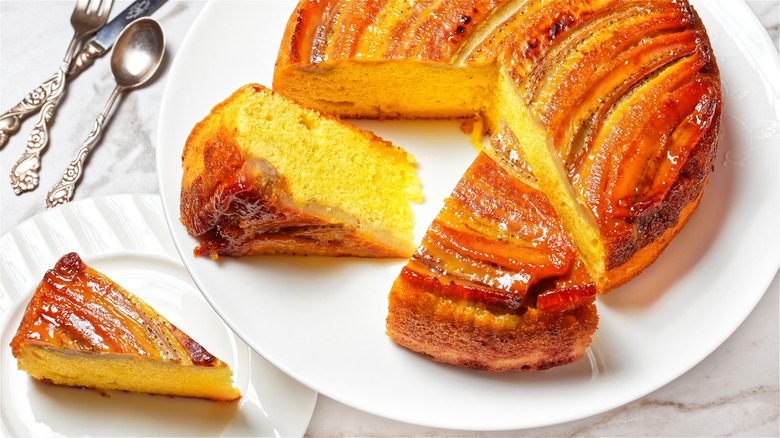Timing Is Key When Using Frozen Fruit In Upside-Down Cake
Out of all the desserts that have amassed popularity over the years, upside-down cakes have garnered a notion of nostalgia for many Americans. Regardless of whether you're a vintage recipe connoisseur, many home chefs have either attempted to make upside-down cakes or have at least consumed a slice of the one and only pineapple upside-down cake. Traditionally, a neutral-flavored batter is poured over pineapple rings that have been drenched in a sweet and salty mixture of butter and sugar that in a sense, caramelizes with the intended fruit after its instructed bake time. Once cooked, the confection is flipped to reveal a visually appealing fruit-covered topping.
Fast-forward to 2023, and pineapple rings are no longer the only fruit of choice for these inverted cakes. While you may feel comfortable extending beyond the bounds of your comfort zone in choosing peaches, berries, or even sliced bananas, you might wonder if there are any rules when it comes to using frozen fruit in these upside-down confections.
Fortunately, frozen fruit is a perfectly fine choice when crafting your next vintage dessert. However, you may need to adjust the cake's cooking time. When frozen fruit is directly added to upside-down cakes, access moisture from this icy produce becomes absorbed by the batter during cooking time. This can, in turn, affect the overall structure of the cake. Therefore, additional time in the oven to soak up any excess moisture may be beneficial.
How much extra cooking time do upside-down cakes need when made with frozen fruit?
You might already know that nutritionally, frozen fruit is often a better buy than canned. But adding this icy produce to your next upside-down cake requires some minor cooking adjustments.
Even without the use of frozen fruit, upside-down cakes are already suggested to bake until there are no visible signs of batter or crumbs when tested with a knife or toothpick. The top of the cake should be a deep golden-brown color, with a slightly visible caramelized crust along the outer edge of the pan before completely removed from the oven. Although the same protocol should be followed for cakes made with frozen fruit, your homemade confection may need up to 10 extra minutes in the oven, depending on the variety of fruit you choose and whether or not you thaw the frozen produce.
Water in frozen fruit expands, which can add extra liquid to the cake, affecting its overall structure. If frozen fruit is added directly to the base of an upside-down cake, once thawed, this pre-frozen fruit can take on a softer, sometimes mushy texture due to the overflow of excess water from the freezing process. To avoid this, simply give your cake extra time in the oven to absorb the excess liquid. Alternatively, you can also make an effort to partially thaw frozen fruit before adding it to the base of your next inverted confection.
When making an upside-down cake with frozen fruit, consider these extra steps
To follow the fruit-cutting tip that's vital for a perfect upside-down cake, you need to have fresh fruit or fruit that has a noticeable amount of structure. If frozen fruit is all you have, there are some additional tips worth considering when making an upside-down dessert.
If you're worried about the excess moisture from frozen fruit, consider thawing it before covering the bottom of a springform pan. However, keep in mind that fruit varieties, such as strawberries and blackberries, will break down significantly and lose any semblance of structure, due to their high water content. Fruits such as bananas, blueberries, and mangoes have slightly less moisture, making these options ideal for freezer-to-pan preparation. These fruits can be used right from the freezer without compromising the integrity of the cake.
Regardless of whether or not you decide to pre-thaw frozen fruit, once the cake is done cooking, give the pan an uninterrupted rest of approximately 15 minutes before inverting it out of its baking vessel. The extra time the freshly baked cake has in the hot pan will help solidify the caramel-like mixture of sugar, butter, and fruit and will result in a sturdier cake. Frozen fruit works just as well as fresh in homemade upside-down cakes. Just make sure you allow extra baking time so any extra moisture is absorbed accordingly.


